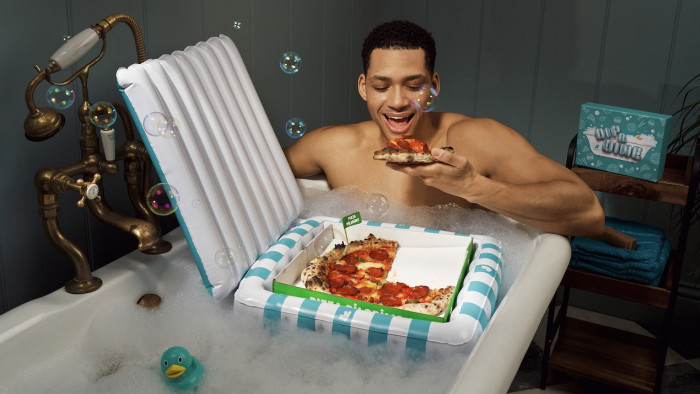Is this the end of advertising’s “bumbling bloke” trope?
For decades, advertisers have relied on the tired trope of the "man child". Will new regulations make him disappear?


An unnamed man is standing in the kitchen, whistling. He is cracking eggs to make breakfast – but he is doing it badly. The first, cracked on the side of his cooker, ends up all over his hob. The second, cracked on the edge of a glass bowl, misses spectacularly – yolk and shell spread across the counter. The third lands on the floor. Is this man drunk? Does he have an undiagnosed condition tragically affecting his hand-eye coordination? No, he’s just a normal man, acting like every normal man does. At least, in adverts.
“Men Can’t Keep House” is a TV Trope that has plagued advertising for decades. In an advert for the American fast food chain Carl’s Jr., a man is seen cracking eggs abysmally before a narrator declares: “Without us, some guys would starve”. Products in the cooking, cleaning, and caring industries are frequently advertised with similar tropes: Branston Pickle says men can’t bake cakes, Persil claim men can’t use washing powder without spilling it all over the floor, and Oven Pride has been advertised with the slogan “So easy, a man can do it”.
As far as sexism goes, the “bumbling bloke” trope is far (far, far, far, far) from the world’s biggest problem. The reason marketers and audiences find humour in it is precisely because men have traditionally been presented as cool, collected, and in charge – this is a subverted trope. Yet although complaining about the trope in itself veers in to “meninist” territory, the trope also negatively affects women by presenting a world in which only they can run the household and do the chores. Last year, the Advertising Standards Authority (ASA) conducted a report that found gender stereotypes in adverts “can lead to mental, physical and social harm which can limit the potential of groups and individuals”.
As a result, in July 2017 the ASA announced they would take a “tougher line” on these adverts, and for the first time the Committee of Advertising Practice (CAP) is offering guidance to advertisers on what the new stance mean in practice, and launching a public consultation on the rules.
CAP’s examples of gender portrayals with fall foul of the new rules include:
1. An ad that depicts a man with his feet up and family members creating mess around a home while a woman is solely responsible for cleaning up the mes
2. An ad that depicts a man or a woman failing to achieve a task specifically because of their gender e.g. a man’s inability to change nappies; a woman’s inability to park a car
3. An ad that belittles a man for carrying out stereotypically “female” roles or tasks
Other examples include ads which mock physiques that aren’t “stereotypically ideal”, ads which contrast a boy’s stereotypical personality (for example, daring) with a girl’s (caring), and ads which tell new mums that “looking attractive or keeping a home pristine is a priority over other factors such as their emotional wellbeing.”
The public consultation – which closes on 26 July – will decide whether the new rules on gender stereotypes are introduced to the Advertising Codes.

A man (familiar with manly tools) struggles to chop a lettuce (a woman’s vegetable)
Is this the death of the bumbling bloke? The ASA make it clear that only gender stereotypes that “cause harm” or “serious or widespread offence” will be banned, so gender stereotypes in themselves aren’t automatically a problem. The organisation is also a regulatory body, not a pre-emptive one, so they will only enforce the rules if an advert gets a significant number of complaints. So far in 2018, the ASA has dealt with 299 cases relating to the depiction of women, and 176 regarding depictions of men.
Beyond the bumbling bloke, these new rules could help to do away with even more damaging stereotypes. In 2014, the ASA did not uphold complaints against a KFC advert in which a man was mocked for having scented candles. In reply, the man said: “You know those candles help with my anxiety… You’re a monster.” The advert equated anxiety with femininity, arguably stigmatising men with the disorder. It is unclear whether the ASA’s new rules on gender stereotyping would see this advert banned, but it is encouraging the body now has a policy acknowledging the damage these stereotypes cause.
The bumbling bloke trope isn’t going to disappear overnight, but these new regulations may mean it slowly disappears from ads. To combat damaging stereotypes that only women can and should clean, advertisements may increasingly feature men doing household tasks. In turn, this may help to normalise chores as genderless and thus improve real lives (research shows British women still do 60 per cent more housework then men). Not only will adverts now better reflect real life: they may also help to change it.
(Pics: Getty)








